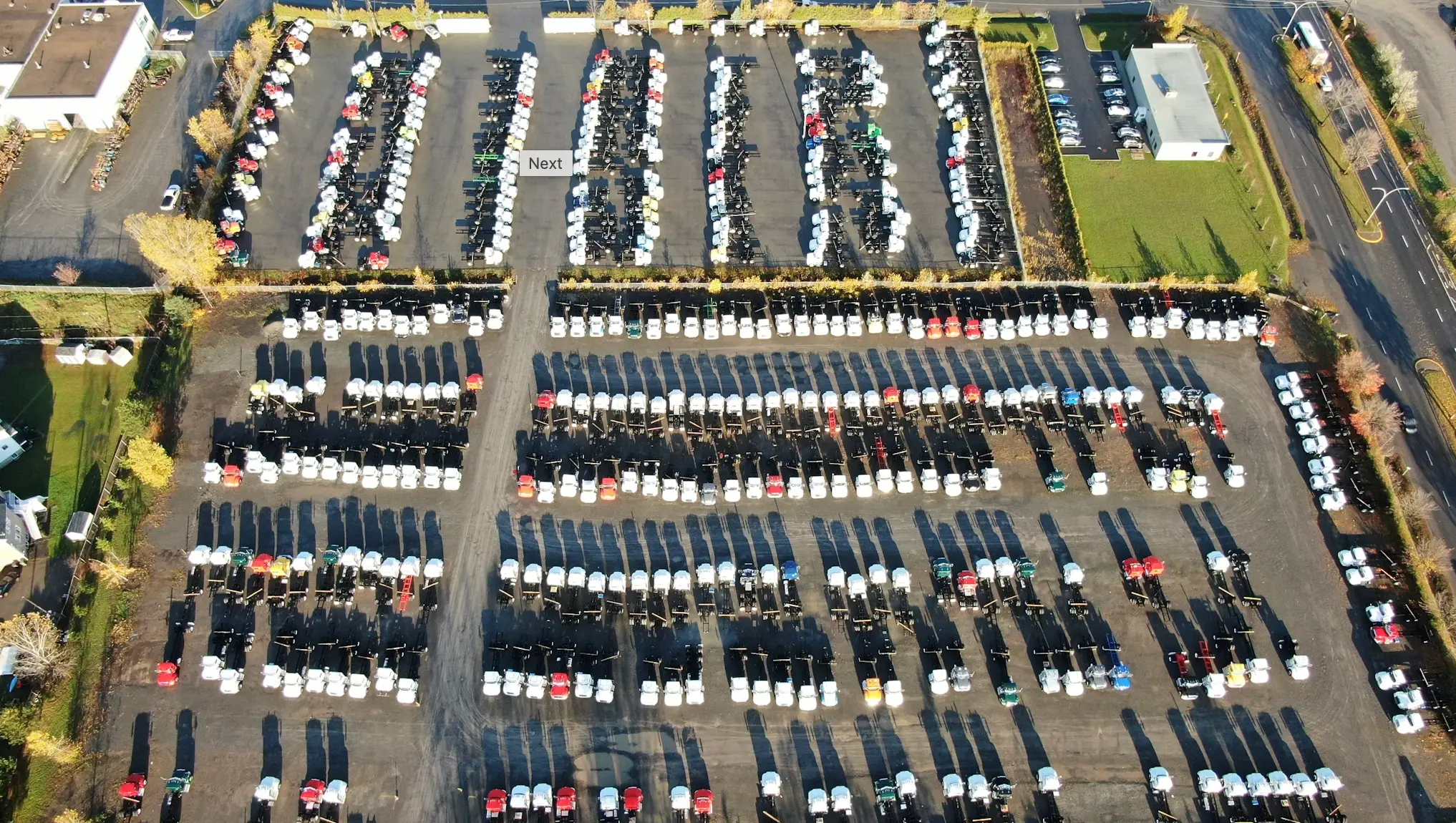The logistics industry is facing unprecedented challenges. Supply chain disruptions, labor shortages, and rising customer expectations have revealed critical weaknesses in traditional warehouse operations. At the heart of these issues is a often-overlooked problem: the yard.
Your yard isn't just a parking lot—it's the connection between your gate and dock, where delays build up and inefficiencies multiply. Manual tracking, paper-based processes, and disconnected systems create blind spots that cost you time, money, and competitive advantage.
AI-powered Yard Management Systems represent a fundamental shift in how warehouses operate. These intelligent platforms combine computer vision, real-time data integration, and automated workflows to transform chaotic yards into strategic control points. You gain visibility into every asset, automate repetitive tasks, and make data-driven decisions that ripple across your entire supply chain.
The future of logistics belongs to warehouses that embrace warehouse logistics innovation. If you're still relying on legacy systems, you're already falling behind.
The Growing Complexity of Modern Warehouse Logistics
Supply chain complexity has reached unprecedented levels. You're dealing with shorter delivery windows, unpredictable demand spikes, and customers who expect real-time visibility into every shipment. Your yard has become a pressure point where these demands collide with physical constraints.
Labor shortages hit yard operations particularly hard. You need experienced spotters, gate attendants, and yard managers, but finding qualified personnel becomes more difficult each year. When you're short-staffed, trailers sit longer, drivers wait at gates, and detention fees pile up. The gap between what your operation needs and what you can staff creates a daily struggle.
Rising freight costs make every minute of inefficiency expensive. Each delayed trailer, each misplaced asset, each manual gate transaction adds to your operational spend. You're watching detention fees climb while operational inefficiency compounds across your network.
Manual processes and legacy systems can't keep pace. When your team relies on clipboards, radio calls, and spreadsheets to track hundreds of trailers, you lose visibility. You can't find assets quickly. You don't know which trailers are ready for loading. Your gate processes bottleneck during peak hours because each transaction requires manual data entry and verification.
These legacy approaches create cascading delays. A driver arrives for pickup, but you can't locate their trailer for 45 minutes. Your dock doors sit empty while loaded trailers remain buried in the yard. Appointments slip, carriers charge fees, and your warehouse throughput suffers.
Understanding AI-Powered Yard Management Systems
An AI-native Yard Operating System represents a fundamental shift from traditional yard management approaches. You're looking at a sophisticated technology stack built from the ground up with artificial intelligence at its core, not bolted on as an afterthought.
The foundation rests on three critical technology components:
1. Computer vision technology
This is where the magic happens. Advanced cameras equipped with AI-powered computer vision automatically identify and track every asset entering, moving through, and exiting your yard. You get real-time visual data capturing trailer numbers, equipment types, and asset conditions without manual scans or human intervention. The accuracy rates reach 99.5%, eliminating the data gaps that plague traditional systems.
2. Real-time data infrastructure
Your yard generates massive amounts of data every minute. An AI-powered YMS processes this information instantly, creating a live digital twin of your physical yard operations. You see exactly where every asset sits, how long it's been there, and what needs to happen next.
3. Intelligent automation workflows
These technologies work together to automate decision-making processes that previously required constant human oversight. The system learns your operational patterns, predicts bottlenecks before they occur, and automatically triggers the right actions at the right time. You're moving from reactive firefighting to proactive yard orchestration.
Key Features Driving the Future of Yard Management
An AI-powered Yard Management System stands out with its intelligent features that tackle the biggest operational challenges.
1. Predictive Analytics for Proactive Operations
Predictive analytics is the backbone of modern yard operations, allowing you to forecast congestion patterns before they disrupt your workflow. With this feature, you can:
Anticipate peak traffic periods
Identify potential bottlenecks
Allocate resources proactively instead of scrambling to manage chaos
2. Automated Scheduling for Efficient Appointments
Automated scheduling changes the way you handle inbound and outbound appointments. The system intelligently sequences arrivals based on dock availability, carrier priorities, and operational capacity. This means:
No more manual coordination that takes up hours of administrative time
Reduced gate queues and driver wait times
3. Dock Optimization for Maximum Efficiency
Dock optimization algorithms continuously analyze your facility's throughput patterns. The system assigns trailers to specific doors based on load characteristics, equipment requirements, and downstream processing needs. As a result:
Dock utilization is maximized
Unnecessary yard moves that waste fuel and labor hours are minimized
4. Biometric Authentication for Secure Access
Advanced systems use biometric authentication for better security and easier access control. With this feature:
Drivers can check in quickly in seconds instead of minutes
You have complete audit trails without extra paperwork
Identities are verified while important shipment data is captured, creating a smooth gate experience that balances speed with security protocols
Benefits of Using AI-Powered YMS in Warehouses
Warehouses that use AI-powered yard management systems see significant improvements in key operational areas. Here are some of the benefits they experience:
1. Increased Throughput
With automated workflows in place, trailers can move through the facility more quickly and efficiently. This leads to an increase in the number of trailers processed within a given time period, resulting in a throughput improvement of 50% or more.
2. Lower Detention Fees
AI-powered systems help reduce driver wait times by automating check-in processes and optimizing trailer positioning. As a result, some operations have achieved 12% reductions in detention costs. This not only saves money but also strengthens relationships with carriers by respecting drivers' time and schedules.
3. Better Resource Utilization
By using computer vision and real-time data, manual tracking methods are replaced, leading to improved resource utilization. Yard jockeys receive intelligent task assignments based on actual yard conditions rather than outdated information, resulting in more efficient use of their time and skills.
4. Greater Supply Chain Agility
The ability to respond quickly to disruptions, reroute shipments based on real-time capacity data, and make informed decisions using accurate yard visibility gives businesses a competitive edge. The system automatically adapts to changing conditions, adjusting workflows and priorities without the need for manual reconfiguration or lengthy approval processes.
Real-World Impact: Case Examples Highlighting ROI Insights with AI YMS Implementation
The numbers tell a compelling story when you examine actual deployments of AI-powered yard management systems. Terminal's clients consistently achieve rapid ROI in under five months, transforming what was once a multi-year technology investment into an immediate competitive advantage.
Detention Fee Challenge Resolved
Consider the detention fee challenge that plagues most warehouse operations. One large distribution center processing hundreds of daily trailer movements saw their driver detention fees drop by 12% within the first quarter of implementing Terminal's Yard Operating System™. The AI-powered Gate Acceleration™ application reduced their gate transaction times by over 85%, eliminating the bottlenecks that previously kept drivers waiting and meters running.
Cost Savings Case Studies
Cost savings case studies reveal even more dramatic improvements:
A mid-market operator with seven facilities reduced asset search time by 90% through computer vision-enabled real-time tracking
Multiple sites reported 50%+ throughput improvement after deploying SmartYard™ YMS with automated workflows
Gate processing errors decreased by 75%, eliminating costly mistakes and rework
Immediate Operational Improvements
The pattern across these implementations remains consistent: warehouses experience immediate operational improvements that translate directly into measurable financial returns. You're not waiting years to justify the investment—the system pays for itself through reduced labor costs, eliminated detention fees, and increased throughput capacity.
Transforming the Yard into a Strategic Supply Chain Control Point with AI-Powered Solutions
The yard has traditionally been viewed as a passive holding area—a necessary but unremarkable space between the gate and the dock. AI-powered solutions fundamentally change this perception by transforming yards into strategic logistics hubs that actively manage supply chain flow.
With Terminal's Yard Networks capability, you gain single-pane-of-glass visibility across multiple facilities. This real-time connectivity means your yard becomes a command center where you can monitor asset locations, track shipment status, and coordinate movements across your entire network simultaneously. You're no longer managing individual yards in isolation—you're orchestrating a connected ecosystem.
The strategic value becomes clear when disruptions occur. When a carrier delays pickup at one facility, your AI-powered system immediately identifies alternative yards with capacity and available assets. When demand spikes unexpectedly at a specific location, you can proactively redirect inbound shipments to prevent congestion before it impacts operations.
This proactive disruption management extends beyond your four walls. By integrating shipment data and appointment information, you create predictive intelligence that anticipates bottlenecks hours or days in advance. Your yard stops reacting to problems and starts preventing them.
The shift from passive storage to active control point represents a fundamental reimagining of The Future of Logistics: Why Every Warehouse Needs an AI-Powered Yard Management System. You're not just moving trailers—you're orchestrating supply chain velocity.
Selecting the Right AI-Powered Yard Management System for Your Warehouse Needs
When evaluating vendors, it's important to have a clear understanding of your operational requirements and long-term goals. The right AI-powered Yard Management System (YMS) should align with your specific yard complexity, transaction volumes, and integration needs.
Technology Foundation and Accuracy
Look for a system that is built on modern, cloud-based architecture and has a track record of delivering accurate data. It's important to find vendors who can provide 99% or higher accuracy in their computer vision capabilities, as anything lower can lead to data quality issues and hinder automation efforts. When speaking with potential vendors, ask them about their proprietary technology stack and how their AI models perform in different lighting conditions, weather scenarios, and with various types of equipment that are specific to your operations.
Deployment Speed and Scalability
Consider how quickly a vendor can implement their solution. If a system requires extensive digging, complex changes to infrastructure, or lengthy IT projects, it can cause unnecessary delays. The best solutions are those that can be deployed in hours or days instead of months. Additionally, think about scalability—can the system expand across your entire yard network without needing separate implementations at each location?
Integration Capabilities
Make sure that the YMS you choose can seamlessly integrate with your existing warehouse management system (WMS), transportation management system (TMS), and enterprise resource planning (ERP) systems. This will eliminate the need for manual data entry and provide you with real-time visibility for better decision-making throughout your supply chain operations.
Conclusion
The logistics industry is changing quickly, and adopting logistics innovations is no longer a choice—it's necessary for survival. You've seen how Yard Management Systems powered by AI can turn disorganized yards into strategic control centers, providing a return on investment in months instead of years.
The future belongs to warehouses that embrace digital technology now. Picture your yard network functioning as a smooth, intelligent system where every asset is monitored, every action is improved, and every choice is based on data. This isn't just a far-off dream—it's already happening at progressive facilities across North America.
Your competitors are already looking into these technologies. The real question isn't whether AI YMS will become the norm in warehouse operations, but whether you'll be at the forefront or trailing behind this transformation.
Digitized yards offer more than just improved efficiency—they're the building blocks for sustainable and adaptable supply chains that can handle any obstacles that come their way. You have an opportunity right now to position your operations at the forefront of The Future of Logistics: Why Every Warehouse Needs an AI-Powered Yard Management System. The technology is ready. Are you?


:quality(85))
:quality(85))
:quality(85))
:quality(85))
:quality(85))
:quality(85))
:quality(85))
:quality(85))
:quality(85))
:quality(85))
:quality(85))
:quality(85))
:quality(85))
:quality(85))
:quality(85))
:quality(85))
:quality(85))
:quality(85))
:quality(85))
:quality(85))
:quality(85))
:quality(85))
:quality(85))
:quality(85))
:quality(85))
:quality(85))
:quality(85))
:quality(85))
:quality(85))
:quality(85))
:quality(85))
:quality(85))
:quality(85))
:quality(85))
:quality(85))
:quality(85))
:quality(85))
:quality(85))
:quality(85))
:quality(85))
:quality(85))
:quality(85))
:quality(85))
:quality(85))
:quality(85))
:quality(85))
:quality(85))


